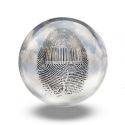Computerware Blog
Biometrics: The New Standard in Security
How Does Biometric Technology Work?
The Kinect uses 3D depth sensors to track your body type, and an RGB camera to identify your facial features. It also employs an array of microphones for speech recognition that can pick up and distinguish multiple users at the same time. The iPhone 5s uses a capacitive sensor made from silicon beneath the home button which captures an 8 x 8 millimeter 500 PPI resolution image of your thumbprint in order to authenticate your print and unlock your phone. Interestingly enough, the biometric technology for the iPhone 5s works for more than just your finger.
Increasing Demand for Biometric Technology
By almost all accounts, biometric security is going to be one of the top technology trends for the next five to ten years. Frost and Sullivan have released a report that concludes fingerprint recognition will remain the leader in biometric technology due to its cost efficiency, convenience, and quick ROI. With Apple recently acquiring the security company Authentic, and Samsung filing for biometric patents, it's only a matter of time before the other major mobile device companies adopt biometric security, or risk being under Apple's thumb. A study conducted by Nuance Communications suggests that 90% of consumers are eager to use voice biometrics to secure their mobile devices. This high demand for biometric technology is hard for device manufacturers to ignore.
Good Intelligence recently released a report entitled "Mobile Biometric Security - Market Forecast Report 2013 - 2018" which predicts that there will be over 3.4 billion people using mobile devices employing biometric technology by 2018, and by 2017 they estimate that almost one billion mobile devices will use fingerprint sensors. With this biometric security evolution, buttonless sensors built into touchscreens will become common. Sales generating from these trends will include multi-factor authentication (MFA) and payment services, which is estimated to be an $8.3 billion industry by 2018.
Making Payments with Biometrics
Making digital payments is one arena that has been reluctant to adopt biometric technology. This is due to the lack of a uniform platform that can be used across all devices. AGNITiO is trying to change this with their Voice ID software engine. AGNITiO CEO Emilio Martinez explains, "The AGNITiO Voice ID software engine can be immediately added to any device, platform, or application, which allows for rapid ecosystem adoption. Soon consumers in a variety of scenarios will identify themselves with their unique voiceprint, in any language, electronically or by phone in a variety of scenarios."
Biometrics Research Group notes that mobile devices are expected to drive banks to adopt voice biometrics. Asia is expected to lead the growth with biometrics used for financial transactions. Barclays' Wealth Management and The National Australia Bank have already began implementing voice biometrics for customer authentication. Jack Ives of Machine Vision Company states, "Ultimately, the goal is to be able to recognize a person in natural motion through any scene...A department store or bank could have a system which is able to recognize each person as they approach the counter."
What's the Future of Biometrics Look Like?
This technology is still in its infancy and the possibilities are endless and touch on a variety of fields. Changing roles of big data and analytics will create entire new business models and software will need to be written to utilize these tools. Commercially, biometrics will likely go further than wearable technology and be harnessed in ways that will make science fiction seem like a reality. How will you utilize this emerging market to your company's benefit? Only time will tell, and you can rest assured that Computerware will be there to walk you through it.


Comments